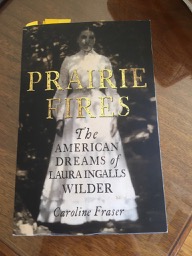
I’m sure that I’m not alone in coming relatively late to this whole FIRE thing. Surely not everyone who latches onto this idea of financial freedom is a bright-eyed twenty or thirty-something who has all the time in the world to get their financial act together and then spend untold decades doing exactly whatever they want to do.
Some of us must surely be like me. I spent my twenties beginning my career, breeding and showing dogs as a hobby, getting married and starting a family. You know… the usual. My thirties were spent raising my boys, divorcing my husband and then re-establishing myself back into my career field. I was paying my bills, supporting my family and doing all the right things that were expected of me. I focused on becoming debt-free and paying off my mortgage, which I did just before I turned 50. I knew dimly that it wasn’t the best decision in a mathematical sense, but security was extremely important to me, so it was the right decision for me. I paid off the house.
But what then? I looked ahead and saw that unless I started getting serious about investing, I’d be doomed to confiscating mobile phones, trotting around on yard duty and marking essays until I was 70. I love teaching, but I don’t think it’d be much fun doing it in a zimmer frame. But I knew absolutely nothing about investing, aside from vague references to “blue chip shares” and seeing the 10 seconds worth of financial stock market stuff on the news every night.
I was scared. Literally scared.
I’m sure I can’t be the only person who has felt this.
I joined an investment group with the Barefoot Investor, which back then was wonderful… but has since devolved into a product that isn’t as good as it once was. But at the time it was great. I started a small share portfolio, made some very savvy friends and felt a little better. I was doing something, and action always feels better than inaction.
But then I started wondering. How much is enough? How do you know when you have enough to retire? I come from fairly long-lived stock. Two of my grandparents lived till their mid-90’s. Grandma was left in a comfortable financial situation by her husband, but my Grandad on the other side of the family ran out of money in his late 80’s and had to rely on my parents to prop him up when he needed more than the pension. He retired when he was 59 and I’m positive that he would’ve thought that he’d be fine. Looking at the two different scenarios, I know which one I’d rather be living when Old Lady Frogdancer hits 110 and is planning her next trip overseas…
But given all this, how do you know what amount of money to aim for?
Soon after joining the Barefoot Blueprint, I stumbled across the world of personal finance blogs. I’ve been blogging since 2008, but I was primarily in the crafts and permaculture world. The personal finance area was a revelation of education and paradigm-widening information. The very first blog I found was Go Curry Cracker – in fact, I asked him in a comment what FIRE meant. Talk about coming late to the party! One of the first posts I read was about this thing called the 4% Rule. I was intrigued but didn’t fully understand, as Jeremy went into a lot of advanced graphs and Maths, which wasn’t great for someone like me who didn’t have their head around the concept and was scared of Maths. (Still am.)
Then shortly afterwards, I found the blog post that so many people reference and point to as the one that explains it all. Mr Money Mustache’s post about the shockingly simple Maths about retirement. (I’ve included a link at the end of this post.)
It blew my mind.
The 4% Rule is based on a massive mathematical study that some uni guys did in Trinity University, where they studied how many portfolios would last over a 30-year span, based on differing rates of spending over that time. They studied what would happen if people started their retirements in every year, starting from 1926 in rolling 30 year periods. They demonstrated that in a portfolio of 50% shares and 50% bonds, (which is WAY conservative), you’d end up with money still in the kitty in 96% of cases if you kept your spending to 4% of your portfolio. Many times, you would have ended up with MORE money in your portfolio than when you started. Not bad odds…
I’ve included the links with all the Maths at the bottom of the post. No way am I going to try and explain all of that when others have already done it so clearly. Plus, you know… Maths. *shudder*
But the crux of the matter is that if you take your anticipated annual spend and multiply it by 25, you get the number that you need to stash into your portfolio to be able to support yourself in retirement. I have no idea how or why it works; I think it’s magic or something. But this is the way to find your number.
Now THAT gives you something to aim for. I dare you… think of a figure you think you’d need to live on and times it by 25. That’s how much you need to have amassed in savings/investments before you should think of retiring if you want to be a self-funded retiree and not totally rely on the old-age pension. As long as I have a calculator handy, even I can do that. I can tell you, I was dancing the fandango when I realised that I finally had something concrete to aim for.
The amount of money will be large. For example, if you think you could live comfortably on 40K/year, you need a cool million. 50K? that’d be 1.25 million. 60K? 1.5 million. At first sight that’s intimidating, especially if, like me, you’re starting a little later than some.
The beauty of it is that we have a lot of control over most of it.
Here in Australia we have a pretty good system with regards to superannuation. Every employer has to pay 9.5% of your wage into a super account that YOU can choose. Most people passively go into the one that the employer selects for them, but with a bit of homework on some comparison sites, you can work out pretty quickly if this option is the best one for you. If you decide you’d prefer to have your money work harder for you in a different fund, it’s extremely easy to change.
So you already have nearly 10% of your wage going into super. You may choose to let this bubble along if you’re young and have plenty of time on your side while making other investments along the way. If, however, you’re like me on the shady side of 50, super is an excellent way to accelerate your savings for retirement. The tax advantages are huge.
I’ve had a couple of conversations lately with people who still don’t salary sacrifice. It’s scary to think of how many people there are who don’t take advantage of this excellent way to get more bang for your buck while saving for Old Lady/Man……..(insert your own name here) …’s quality of life. If you choose to salary sacrifice, every dollar of your wage that gets taken out and put into super is taken out FIRST. It’s taxed at only 15%… then the rest of your wage is then taxed at your normal amount. This means that even though you may choose to salary sacrifice $600/pay like I do, you get more money in your pay than you’d initially think. My wage didn’t drop by $600. It only dropped by $450 or so, which means that I have an ‘extra’ $150 to play with. Again, it’s some magical incomprehensible Maths thing. But without a word of a lie, every single person I’ve persuaded to start salary sacrificing comes up to me after their first payroll deduction and says something like, “I can’t believe how much money I’ve still got!” It’s true – you steel yourself for your pay to drop by the amount you’ve nominated, so it feels like you’ve received a pay rise when you get more back than you were expecting. You can put in up to 25K a year, including what your employer puts in. It’s brilliant.
We also have a HUGE amount of control over our annual expenses. After all, this is the figure that will determine the ‘times 25’ of the 4% Rule. If you have a burn to retire earlier than age 67, then if you reduce the amount you need to live on, your magic retirement goal number will be less. This is why I call myself a value-ist. I’ll spend big bucks if I have to on the things I think bring joy and value to my life, (hello $2,000 miniature wire-haired dachshund!), but I’ll either drastically reduce or eliminate the things I feel that don’t.
For example, everyone talks about the latte factor – how if you stop buying that $3.50 cup of coffee every day when you go to work you’ll save $840/year. We’ve all heard it. My sister Kate and I have vastly different attitudes to buying a daily coffee. To be frank, I think it’s a waste of money. My school actually supplies plunger coffee, tea and instant coffee for free. My attitude is, ‘Thanks very much!’ Do you know how many people in my staffroom walk up to 711 to buy a coffee every morning? Then during the day, someone will say, “I’m just popping up to AJ’s for a coffee. Anyone want one?” and the hands go up. I don’t get it. They have the common room to sit and socialise, just like in a café, and they can get their coffee for free. My sister, on the other hand, derives immense joy from her daily coffee. She loves trying out different places, the different tastes of coffee beans, the social aspect of a busy café… for her it’s an expense she feels adds a huge amount of enjoyment to her life. You’d have to prise that coffee out of her cold, dead hands before she’d give it up, so she continues to spend money on this, whereas I have almost totally eliminated it from my life.
When you get the bug for organising yourself towards retirement, one of the most useful things you can do is to track your spending. Over time, you can see where the necessary spending is and, most importantly, where the wasteful spending comes in. Then it’s a simple matter to plug the holes and bring your annual expenses down. When we become aware of those little day-to-day purchases that are so small that we disregard them at the time we make them but which can add up over time to be almost frightening… this is definitely an empowering thing to do in life. Once you’re aware, you have the choice to continue along the same path or to change. If you’re never aware; you can never have the choice.
I guess what I’m saying is that conscious frugality in the areas that suit your life is a cornerstone of the FIRE life. That’s why I’ve decided to include “Frugal Friday” into this blog.
Another way to accelerate your savings towards your magic number is to increase your income. I have no useful input with regard to getting promotions and pay rises from your job. I work in the public sector in the education field, where pay rises are automatic each year and promotions are limited in the school I’m in, so I have no real experience. But a side hustle? THAT I know about.
Sacrificing a little bit of tv watching time to bring in more dollars is the classic short-term pain for long-term gain thinking. I did this for years, searching for a solid money-making opportunity that would be worth my while. My last side hustle enabled me to pay off my house years earlier, then to save and pay cash for a 30K trip around the UK and Europe. Then I funnelled the cash I earned into investments. Was it worth my while? If you’d asked me that when I was swanning around Hampton Court Palace in a red velvet cloak, I would have laughed in your face. My side hustle was tiring and made my life much busier, but it enabled me to get out of debt which then freed up a large amount of money that I could direct into investments and an extravagant trip of a lifetime without sacrificing my savings towards super and shares. If you eliminate debt it enables you to turbocharge your path to your magic number.
 One of the best days of my life! Thank-you, side-hustle.
One of the best days of my life! Thank-you, side-hustle.
A wonderful thing to keep in mind is that you have control over the magic number you aim for. Personally, I’m keeping current annual costs as low as I can, while working towards an annual figure far larger than I need to live on to survive. My magic number is designed to let Old Lady Frogdancer thrive! Therefore, my personal 4% Rule number is inflated beyond my current spending, to take into account all the travel I intend to do. This is an easy decision for me to make as I still enjoy my job and don’t mind working a few extra years to build up some more money. Someone else may be in a different position, where they hate their job and by cutting unnecessary expenses they can bring forward retirement and they can start enjoying the freedom of that lifestyle. We all have great control of our own paths – if we make conscious decisions.
I’m a big fan of the 4% Rule as it’s an easy formula to get your head around. For someone just starting to grapple with these ideas, it gives you a giant bulls-eye to aim at, which is incredibly empowering. Later, as people get closer to the time they decide to pull the pin, their investment decisions can be modified to their individual requirements. Who says you HAVE to pull out 4% every year? You may decide to go more conservative with a 3.5%, or more aggressive with a 5% rate of withdrawal. You may choose to factor in a part-pension, or to remain totally self-funded. You may want to leave a legacy to family or charity or go screaming to the finish line of life clutching your last dollar in one hand and a martini in the other. Those more detailed plans can come later, as you become more educated and you start fine-tuning your investment plans. But for broad-brushstroke planning, the 4% Rule offers as much certainty for forward planning as you’re likely to get.
***
Here are the two articles that sent me on this path. I’ve included the simpler one first, with the more detailed one following for those who want to go deeper into the concepts. The comments are well worth reading too, as people query and discuss things. They bring up points and debate them, which deepens the knowledge, which is a pretty good thing.
Mr Money Mustache’s post on “The Shockingly Simple Math Behind Early Retirement” is HERE.
Go Curry Cracker’s post on “What is Your Retirement Number – the 4% Rule” is HERE.
Enjoy!
















 One of the best days of my life! Thank-you, side-hustle.
One of the best days of my life! Thank-you, side-hustle.







